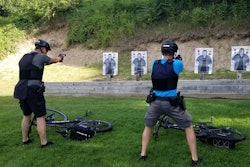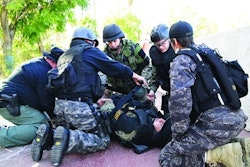On Sept. 12, 2001, we were a nation united. Terror had struck our homeland. As the fires still smoldered in Lower Manhattan, Northern Virginia, and Western Pennsylvania, Americans everywhere had adopted what soon became known as the "9/12 Mindset."
With the passage of the USA Patriot Act, law enforcement at every level—federal, state, and local—were in some way or another conducting counterterrorism operations on "the new front lines" of the "war on terror."
Billions of dollars flowed in every direction, funding new technology, new tools, and increased training, all targeted toward "preventing the next 9/11."
The mantra became, "see something, say something" and JTTFs were flooded with leads—most of them useless.
Everyone was watching, and working, and thinking, and training.
Multi-agency sting operations were set in motion, nascent cells were infiltrated and busted, and some legitimate attack plans were thwarted—the 2010 Portland Christmas Tree plot and the 2019 attempted bombing on Times Square in New York City immediately come to mind.
Then, for two decades, very little happened. There were exceptions of course—most notably the Boston Marathon Bombing—but in many places the urgency of counterterrorism activities faded as the budgets for it slowly dwindled, and the training began to wane.
But the threat remains. So here are some reminders on what law enforcement trainers should be telling officers—from recruits to in-service—about preparing to prevent an attack that is lying in waiting.
Financing Activities
According to a report to the 9/11 Commission by the National Commission on Terrorist Attacks Upon the United States, that plot cost al Qaeda "somewhere in the range of $400,000 to 500,000, of which approximately $300,000 passed through the hijackers' bank accounts in the United States."
A half million isn't an astronomical sum of money by any stretch of the imagination, but it's enough that a person might surmise that raising it would seem difficult to do with "penny-ante" criminal activity.
That person would be wrong.
"Right now, according to the FBI, the cells that are here are just doing criminal things—they're fundraising," says Nikki Burgett, training coordinator for a municipal agency in Oklahoma as well as founder and lead trainer of NJ Burgett LLC (a firm that specializes in training on counter-terrorism and behavioral threat assessment).
That fundraising through criminal activities can come in unexpected forms.
Kevin Gors, a retired officer from the Oakland (CA) Police Department and co-founder of Seal~Mar Protection Services, says that some terrorist organizations have become so diversified and created such unique revenue streams that it really takes some sophistication to keep track of and be aware of what the indicators are.
Gors gives an example of a terror cell recently caught trafficking in pirated movies.
"We had a thing a while back where you had a terrorist organization that was knocking off movie DVDs. They were selling them on the streets for like five bucks a piece. What great effort do we put into identifying and going after people selling illegal DVDs?"
Gors says that eventually authorities uncovered a substantially sized international operation involving three different DVD manufacturing facilities capable of producing about two-and-a-half million illegal DVDs per day.
"They were using the same pipelines that they have previously used for trafficking in narcotics, except now they were trafficking in illegal DVDs and they virtually had no exposure," Gors says. "They could pump out two and a half million DVDs a day at five bucks a DVD—that turns into real money real quick—and with almost no repercussions to them if they got caught for trafficking illegal DVDs. Who's going to jail for that?"
Indeed, financing activities aren't necessarily high-profile criminal acts such as money laundering from drug running, human trafficking, or bank robberies, and can take even the most benign form of simple out-in-the open fundraising.
This has been found in radical mosques, of course, but can also be seen in the activities of what the FBI calls domestic violent extremists (DVE) and homegrown violent extremists (HVE)—"two distinct threats, both of which are located primarily in the United States and typically radicalize and mobilize to violence on their own."
Mark Fallon, director of Club Fed LLC (an international security company) says, "The much greater threat we have right now within the Homeland—within the United States—isn't really from international terrorist groups. Al-Qaeda is not what it was—it's been on the decline for years. What is on the rise are these local domestic violent extremist groups—the sovereign citizen groups, the oath takers, and others."
Fallon continues, "We have a right of free speech. We have a right to protest against our government. We do not have a right to take illegal action against our government."
Baselines & Anomalies
In their excellent book, "Left of Bang: How the Marine Corps' Combat Hunter Program Can Save Your Life," authors Patrick Van Horne and Jason Riley describe a concept of behavioral analysis used in the Combat Hunter Program to proactively recognize potential threats that goes beyond generic situational awareness.
"If you look for normal, abnormal stands out," Burgett says. "We question people all the time and we're asking ourselves, 'Are they victim, witness, or suspect?' It's the same tactic. Once we decide the baseline for the [individual] we can see what is standing out in that situation."
Burgett illustrates this concept through an incident in which a friend of hers working for a federal agency was abroad and returning with her team to their hotel after a day's work.
"She sees that this guy has traditional Arab garb on, but she also notices that he wasn't wearing sandals—that's what everyone wears—but instead had combat boots on," Burgett says.
"The team had finished their work, so they left [for home] early, and while they were in the air, the hotel was hit—it was bombed. It was that little thing. She noticed the sandals—well, the boots instead of sandals."
Burgett says while there are high-risk behaviors—such as setting a backpack down and then walking away—most police officers would quickly pick up on, there are a host of actions that might initially seem innocuous but could be important.
"One low risk [behavior] would be recording. Way back in the day, you had to have a recording device—a small handheld recorder. Nobody keeps those anymore—everybody uses their phone. Well, what's the difference?"
Burgett continues, "Can you look at somebody and honestly say, 'Okay, they are live streaming and they're looking at themselves' or are they actually recording something else... they're pretending to take selfies and they're not. They actually have the phone flipped the other direction—the camera flipped the other way—and they're casing a joint. They're taking pictures. They're in the planning stage."
Gors describes the work of a single patrol officer in Florida who simply noticed a few things about a local business that were inconsistent, incongruous, interesting—and worthy of some further investigation.
Gors says, "One intuitive guy said, 'Hey, why is there so much traffic going in and out of this store? Why are there a lot of people [coming and going] that don't live in this neighborhood? Why is this store not seeming to be doing better business-wise than it is?' So he started really doing work, tagging cars, running plates, tracking numbers of people going in and out, looking at where they're from, where they're going... He eventually wound up figuring it out that this 'mom and pop store' was a money laundering facility for a terrorist organization overseas. It was doing about three million a year in laundered money. Three million a year can buy a lot of terrorist toys."
The key, of course, is doing the work and not making assumptions.
Fallon—whose focus is on DVEs and HVEs—says that officers should guard against making hasty conclusions about things that might lead an untrained eye to believe something—such as simple as a Gadsden flag bumper sticker or a social media post critical of the government—to be an automatic indicator of violent extremism.
"We ought to be critical of our government—that's what a democracy allows us to do," Fallon says. "It also allows us free speech. When it becomes a problem is when it goes from ideology to action... this attack continuum where you see an escalation of rhetoric [into] more overt acts that would tend to indicate that an individual would be more inclined to take some action."
Red-Teaming Targets
From a very practical perspective at a very local level, police trainers and leaders should encourage officers to look at their jurisdictions through the eyes of a terrorist and answer the question, "What people, places, or events do I have in my area that would get the biggest headlines if they were hit?"
This soft-target awareness is the simplest form of red teaming.
Gors says that red team training exercises have the added benefit of helping people who are somehow unwilling or unable to see the threat of terrorist attacks occurring again in America.
"You can take someone who may not believe in the threat and through a limited amount of education, show them how easy it is to become an effective terrorist and carry out an effective terrorist operation that causes real damage," Gors says. "Once they see it, then you're going get them to start taking the threat seriously. You have to make them believe in the threat to even have a shot at getting them to actually do what's necessary to identify these things."
Gors adds, "We need to understand what the bad guy's goal is—what they're trying to accomplish—so we know how to counter it."
Fallon cautions against looking too hard for potential targets. He instead tells officers to spend more time focusing on looking for the essence and the nuance of the community and its residents.
"Patrol officers, investigators, and police departments need to have a much better handle on their own communities," Fallon says. "They really have to embrace their communities so that they have a better understanding of what may or may not be happening from within."
Detect, Deter, Defeat
Much of what Burgett, Fallon, and Gors describe above is an acute attentiveness to what are commonly considered among counterterrorism experts to be the most visible among standard operation procedures for terrorist activities—whether they are conducted by radicalized individuals, small cells, or well-known transnational groups.
Those "pre-attack indicators"—such as financing activities (criminal and otherwise), conducting surveillance, probing/testing security, acquiring supplies, and conducting dry runs—are also common activities of everyday criminals.
As long as trainers are putting officers on the streets that are really good at doing solid everyday police work, those skills are almost certainly going to translate into doing really good work to detect, deter, and defeat terrorist activity as well.
















